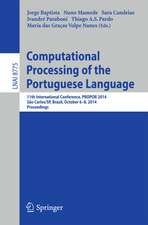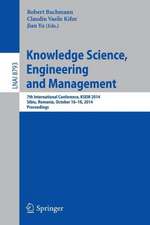Hypergraph Computation: Artificial Intelligence: Foundations, Theory, and Algorithms
Autor Qionghai Dai, Yue Gaoen Limba Engleză Paperback – 16 mai 2023
Many underlying relationships among data can be represented using graphs, for example in the areas including computer vision, molecular chemistry, molecular biology, etc. In the last decade, methods like graph-based learning and neural network methods have been developed to process such data, they are particularly suitable for handling relational learning tasks. In many real-world problems, however, relationships among the objects of our interest are more complexthan pair-wise. Naively squeezing the complex relationships into pairwise ones will inevitably lead to loss of information which can be expected valuable for learning tasks.
Hypergraph, as a generation of graph, has shown superior performance on modelling complex correlations compared with graph. Recent years have witnessed a great popularity of researches on hypergraph-related AI methods, which have been used in computer vision, social media analysis, etc. We summarize these attempts as a new computing paradigm, called hypergraph computation, which is to formulate thehigh-order correlations underneath the data using hypergraph, and then conduct semantic computing on the hypergraph for different applications. The content of this book consists of hypergraph computation paradigms, hypergraph modelling, hypergraph structure evolution, hypergraph neural networks, and applications of hypergraph computation in different fields. We further summarize recent achievements and future directions on hypergraph computation in this book.
| Toate formatele și edițiile | Preț | Express |
|---|---|---|
| Paperback (1) | 303.41 lei 6-8 săpt. | |
| Springer Nature Singapore – 16 mai 2023 | 303.41 lei 6-8 săpt. | |
| Hardback (1) | 366.01 lei 6-8 săpt. | |
| Springer Nature Singapore – 16 mai 2023 | 366.01 lei 6-8 săpt. |
Din seria Artificial Intelligence: Foundations, Theory, and Algorithms
- 20%
 Preț: 308.79 lei
Preț: 308.79 lei - 20%
 Preț: 269.01 lei
Preț: 269.01 lei - 20%
 Preț: 376.10 lei
Preț: 376.10 lei - 20%
 Preț: 330.24 lei
Preț: 330.24 lei - 20%
 Preț: 332.06 lei
Preț: 332.06 lei - 20%
 Preț: 816.54 lei
Preț: 816.54 lei - 20%
 Preț: 1383.45 lei
Preț: 1383.45 lei - 20%
 Preț: 593.48 lei
Preț: 593.48 lei - 20%
 Preț: 649.60 lei
Preț: 649.60 lei - 20%
 Preț: 461.53 lei
Preț: 461.53 lei - 20%
 Preț: 352.95 lei
Preț: 352.95 lei - 20%
 Preț: 1641.86 lei
Preț: 1641.86 lei - 20%
 Preț: 1046.06 lei
Preț: 1046.06 lei - 20%
 Preț: 989.96 lei
Preț: 989.96 lei - 35%
 Preț: 336.99 lei
Preț: 336.99 lei
Preț: 303.41 lei
Preț vechi: 379.26 lei
-20% Nou
Puncte Express: 455
Preț estimativ în valută:
58.07€ • 60.40$ • 47.94£
58.07€ • 60.40$ • 47.94£
Carte tipărită la comandă
Livrare economică 15-29 aprilie
Preluare comenzi: 021 569.72.76
Specificații
ISBN-13: 9789819901876
ISBN-10: 9819901871
Pagini: 244
Ilustrații: XVI, 244 p. 1 illus.
Dimensiuni: 155 x 235 mm
Greutate: 0.4 kg
Ediția:1st ed. 2023
Editura: Springer Nature Singapore
Colecția Springer
Seria Artificial Intelligence: Foundations, Theory, and Algorithms
Locul publicării:Singapore, Singapore
ISBN-10: 9819901871
Pagini: 244
Ilustrații: XVI, 244 p. 1 illus.
Dimensiuni: 155 x 235 mm
Greutate: 0.4 kg
Ediția:1st ed. 2023
Editura: Springer Nature Singapore
Colecția Springer
Seria Artificial Intelligence: Foundations, Theory, and Algorithms
Locul publicării:Singapore, Singapore
Cuprins
Chapter 1. Introduction.- Chapter 2. Mathematical Foundations of Hypergraph.- Chapter 3. Hypergraph Computation Paradigms.- 4. Hypergraph Modeling.- Chapter 5. Typical Hypergraph Computation Tasks.- 6. Hypergraph Structure Evolution.- Chapter 7. Neural Networks on Hypergraph.- Chapter 8. Large Scale Hypergraph Computation.- Chapter 9. Hypergraph Computation for Social Media Analysis.- Chapter 10. Hypergraph Computation for Medical and Biological Applications.- Chapter 11. Hypergraph Computation for Computer Vision.- Chapter 12.The Deep Hypergraph Library.- Chapter 13. Conclusions and Future Work.
Notă biografică
Yue Gao is an Associate Professor of School of Software at Tsinghua University. His main research interests focus on Artificial Intelligence, Computer Vision and Brain Science. He has published over 200 papers in the areas of Artificial Intelligence, 3D Vision, Multimedia, and Medical Image Analysis. Prof. Gao has authored the books " View-based 3-D Object Retrieval" (2014) and " Learning-Based Local Visual Representation and Indexing" (2015). He has been an associate editor for prestigious journals such as IEEE Transactions on Signal and Information Processing over Networks, Journal of Visual Communication and Image Representation, and IEEE Signal Processing Letters. He is a Senior Member of IEEE. He was listed as the Web of Science Highly Cited Researcher and Elsevier Highly Cited Chinese Researchers.
Qionghai Dai is a Professor and the Dean of School of Information at Tsinghua University. He is the member of Chinese Academy of Engineering. His main research interests focus on Artificial Intelligence, Computational Imaging and Brain Science. He has published over 400 papers at Cell, Nature Photonics, Nature Biotechnology, IEEE TPAMI, etc. Prof. Dai has authored the books " View-based 3-D Object Retrieval" (2014), " Learning-Based Local Visual Representation and Indexing" (2015), “3D Video Processing and Communication” (in Chinese, 2016), “Multidimensional Signal Processing: Fast Transform, Sparse Representation and Low-Rank Analysis” (in Chinese, 2016), and “Computational photography: Computational Capture of Plenoptic Visual Information” (in Chinese, 2016). He has been an associate editor for prestigious journals such as IEEE Transactions on Image Processing and IEEE Transactions on Neural Networks and Learning Systems. He is the President of Chinese Association for Artificial Intelligence, a Fellow of CAAI and CAA, and recipient of numerous awards, including the National Natural Science Award of China (three times). He was listed as the Web of Science Highly Cited Researcher.
Qionghai Dai is a Professor and the Dean of School of Information at Tsinghua University. He is the member of Chinese Academy of Engineering. His main research interests focus on Artificial Intelligence, Computational Imaging and Brain Science. He has published over 400 papers at Cell, Nature Photonics, Nature Biotechnology, IEEE TPAMI, etc. Prof. Dai has authored the books " View-based 3-D Object Retrieval" (2014), " Learning-Based Local Visual Representation and Indexing" (2015), “3D Video Processing and Communication” (in Chinese, 2016), “Multidimensional Signal Processing: Fast Transform, Sparse Representation and Low-Rank Analysis” (in Chinese, 2016), and “Computational photography: Computational Capture of Plenoptic Visual Information” (in Chinese, 2016). He has been an associate editor for prestigious journals such as IEEE Transactions on Image Processing and IEEE Transactions on Neural Networks and Learning Systems. He is the President of Chinese Association for Artificial Intelligence, a Fellow of CAAI and CAA, and recipient of numerous awards, including the National Natural Science Award of China (three times). He was listed as the Web of Science Highly Cited Researcher.
Textul de pe ultima copertă
This open access book discusses the theory and methods of hypergraph computation.
Many underlying relationships among data can be represented using graphs, for example in the areas including computer vision, molecular chemistry, molecular biology, etc. In the last decade, methods like graph-based learning and neural network methods have been developed to process such data, they are particularly suitable for handling relational learning tasks. In many real-world problems, however, relationships among the objects of our interest are more complex than pair-wise. Naively squeezing the complex relationships into pairwise ones will inevitably lead to loss of information which can be expected valuable for learning tasks.
Hypergraph, as a generation of graph, has shown superior performance on modelling complex correlations compared with graph. Recent years have witnessed a great popularity of researches on hypergraph-related AI methods, which have been used in computer vision, social media analysis, etc. We summarize these attempts as a new computing paradigm, called hypergraph computation, which is to formulate the high-order correlations underneath the data using hypergraph, and then conduct semantic computing on the hypergraph for different applications. The content of this book consists of hypergraph computation paradigms, hypergraph modelling, hypergraph structure evolution, hypergraph neural networks, and applications of hypergraph computation in different fields. We further summarize recent achievements and future directions on hypergraph computation in this book.
Many underlying relationships among data can be represented using graphs, for example in the areas including computer vision, molecular chemistry, molecular biology, etc. In the last decade, methods like graph-based learning and neural network methods have been developed to process such data, they are particularly suitable for handling relational learning tasks. In many real-world problems, however, relationships among the objects of our interest are more complex than pair-wise. Naively squeezing the complex relationships into pairwise ones will inevitably lead to loss of information which can be expected valuable for learning tasks.
Hypergraph, as a generation of graph, has shown superior performance on modelling complex correlations compared with graph. Recent years have witnessed a great popularity of researches on hypergraph-related AI methods, which have been used in computer vision, social media analysis, etc. We summarize these attempts as a new computing paradigm, called hypergraph computation, which is to formulate the high-order correlations underneath the data using hypergraph, and then conduct semantic computing on the hypergraph for different applications. The content of this book consists of hypergraph computation paradigms, hypergraph modelling, hypergraph structure evolution, hypergraph neural networks, and applications of hypergraph computation in different fields. We further summarize recent achievements and future directions on hypergraph computation in this book.
Caracteristici
The first comprehensive and systematic overview for hypergraph computation Rich blend of basic knowledge, theoretical analysis, algorithm introduction, and key applications Describes hypergraph computation applications in computer vision, medical applications, etc This book is open access, which means that you have free and unlimited access




























